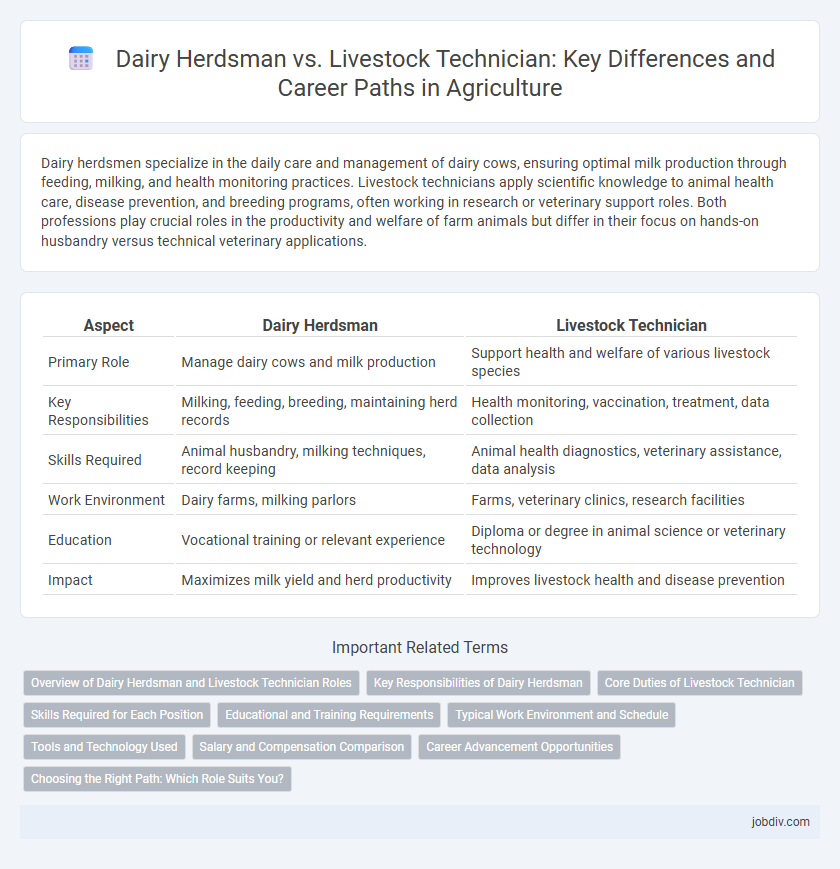Dairy herdsmen specialize in the daily care and management of dairy cows, ensuring optimal milk production through feeding, milking, and health monitoring practices. Livestock technicians apply scientific knowledge to animal health care, disease prevention, and breeding programs, often working in research or veterinary support roles. Both professions play crucial roles in the productivity and welfare of farm animals but differ in their focus on hands-on husbandry versus technical veterinary applications.
Table of Comparison
| Aspect | Dairy Herdsman | Livestock Technician |
|---|---|---|
| Primary Role | Manage dairy cows and milk production | Support health and welfare of various livestock species |
| Key Responsibilities | Milking, feeding, breeding, maintaining herd records | Health monitoring, vaccination, treatment, data collection |
| Skills Required | Animal husbandry, milking techniques, record keeping | Animal health diagnostics, veterinary assistance, data analysis |
| Work Environment | Dairy farms, milking parlors | Farms, veterinary clinics, research facilities |
| Education | Vocational training or relevant experience | Diploma or degree in animal science or veterinary technology |
| Impact | Maximizes milk yield and herd productivity | Improves livestock health and disease prevention |
Overview of Dairy Herdsman and Livestock Technician Roles
Dairy herdsmen specialize in managing dairy cattle, focusing on milk production, animal health, and daily care routines, ensuring optimal herd productivity. Livestock technicians support broader animal care and husbandry tasks, often involving data collection, health monitoring, and assisting veterinarians across various farm animals. Both roles require knowledge of animal behavior, nutrition, and farm equipment but differ in scope and specific responsibilities related to dairy versus mixed livestock management.
Key Responsibilities of Dairy Herdsman
Dairy Herdsmen are primarily responsible for managing the daily care and health of dairy cattle, including feeding, milking, and monitoring herd conditions to ensure optimal milk production. They conduct regular health checks, assist with breeding programs, and maintain accurate records of individual animal performance. Their role is critical in maximizing herd productivity and ensuring compliance with animal welfare and biosecurity standards.
Core Duties of Livestock Technician
Livestock Technicians primarily focus on monitoring the health and wellbeing of farm animals, conducting routine medical treatments, and assisting veterinarians in diagnosing diseases. They maintain detailed health records, manage breeding programs, and ensure compliance with animal welfare regulations. Their technical expertise supports the scientific management of livestock, enhancing productivity and disease prevention in agricultural operations.
Skills Required for Each Position
Dairy herdsmen require strong skills in animal husbandry, milking procedures, and herd health monitoring to manage daily dairy operations effectively. Livestock technicians need expertise in veterinary care, disease diagnosis, and data collection for research or breeding programs. Both positions demand a solid understanding of animal nutrition and welfare to optimize productivity and maintain herd well-being.
Educational and Training Requirements
Dairy herdsmen typically require a high school diploma combined with on-the-job training focused on animal care, milking procedures, and basic farm maintenance, while livestock technicians often pursue postsecondary education such as an associate degree or certification in animal science or veterinary technology. Livestock technicians receive specialized training in animal health monitoring, administering treatments, and collecting samples for laboratory analysis, which enhances their capabilities compared to the practical, hands-on skills of dairy herdsmen. Both roles emphasize knowledge of animal nutrition and husbandry, but livestock technicians benefit from deeper scientific coursework and laboratory experience.
Typical Work Environment and Schedule
Dairy herdsmen typically work on farms in barns or open fields, managing milking schedules and ensuring animal health during early mornings and late evenings, often requiring physical labor and irregular hours. Livestock technicians operate in more controlled environments such as research facilities or veterinary clinics, following structured schedules that align with animal care protocols and data collection routines. Both roles demand hands-on interaction with animals but differ in the predictability and setting of their daily work environments.
Tools and Technology Used
Dairy herdsmen primarily rely on milking machines, automated feeders, and herd management software to monitor cow health and optimize milk production. Livestock technicians use advanced diagnostic tools, such as ultrasound devices, serum analyzers, and genetic testing equipment, to assess animal health and improve breeding outcomes. Both professions incorporate data analytics platforms to track livestock performance, but livestock technicians emphasize precise health diagnostics while herdsmen focus on operational efficiency.
Salary and Compensation Comparison
Dairy herdsmen typically earn between $30,000 and $45,000 annually, with compensation influenced by herd size and geographic location. Livestock technicians often command salaries ranging from $35,000 to $50,000, reflecting specialized skills in animal health and management. Both roles may receive additional benefits such as housing allowances, bonuses, and health insurance, impacting overall compensation packages.
Career Advancement Opportunities
Dairy herdsmen gain practical experience managing herd health and milk production, often progressing to roles such as herd manager or dairy farm supervisor through hands-on training and certifications. Livestock technicians typically pursue formal education and specialized skills in animal science and veterinary technology, opening pathways to advanced positions like livestock production manager or animal welfare specialist. Both careers offer growth potential, but livestock technicians may have broader opportunities in research and biotech sectors due to their technical expertise.
Choosing the Right Path: Which Role Suits You?
Dairy herdsmen specialize in managing milk-producing cattle, ensuring optimal milk yield, animal health, and farm productivity through hands-on care and routine maintenance. Livestock technicians focus on broader animal health management, conducting research, administering treatments, and applying technological solutions across various livestock species. Choosing the right path depends on your interest in either daily herd management and production or scientific and technical work in animal health and welfare.
Dairy Herdsman vs Livestock Technician Infographic

 jobdiv.com
jobdiv.com